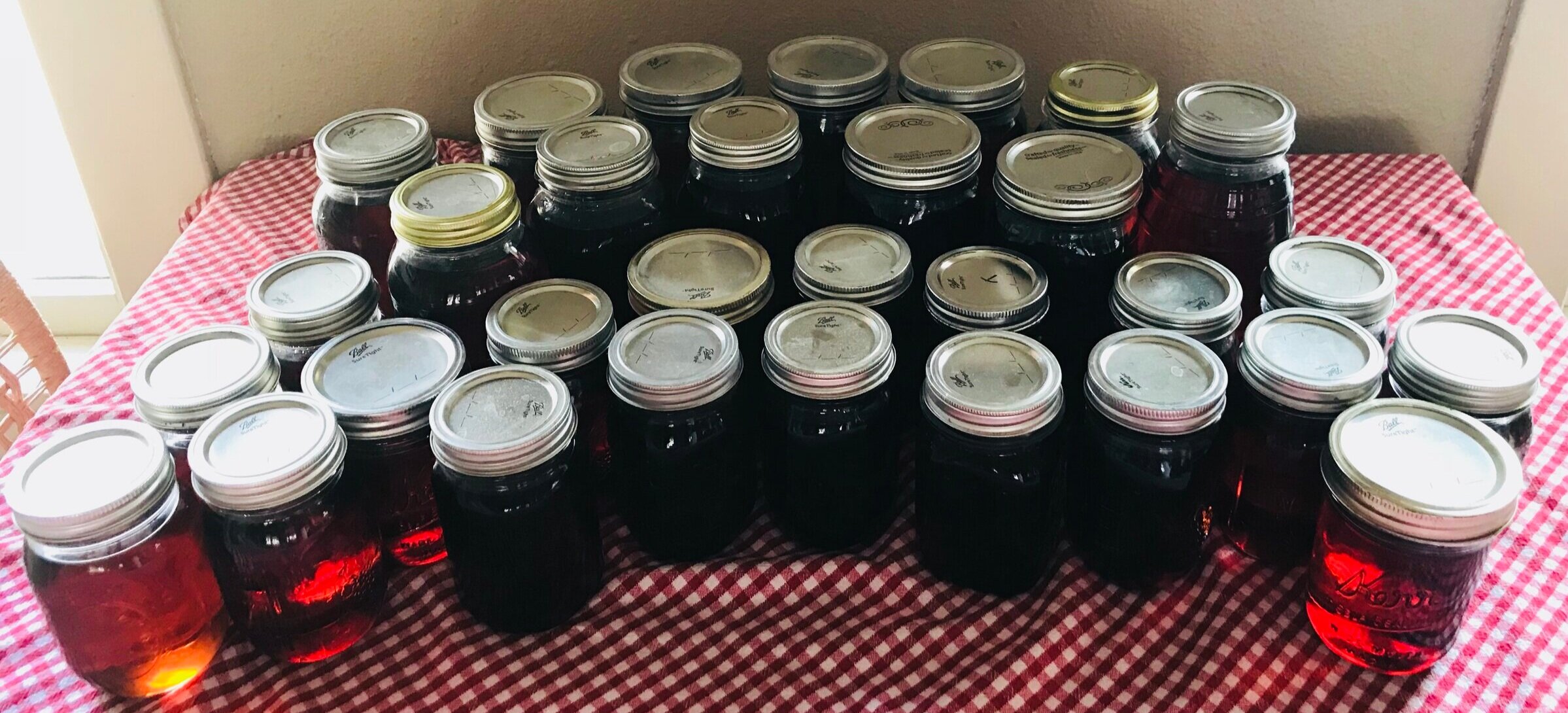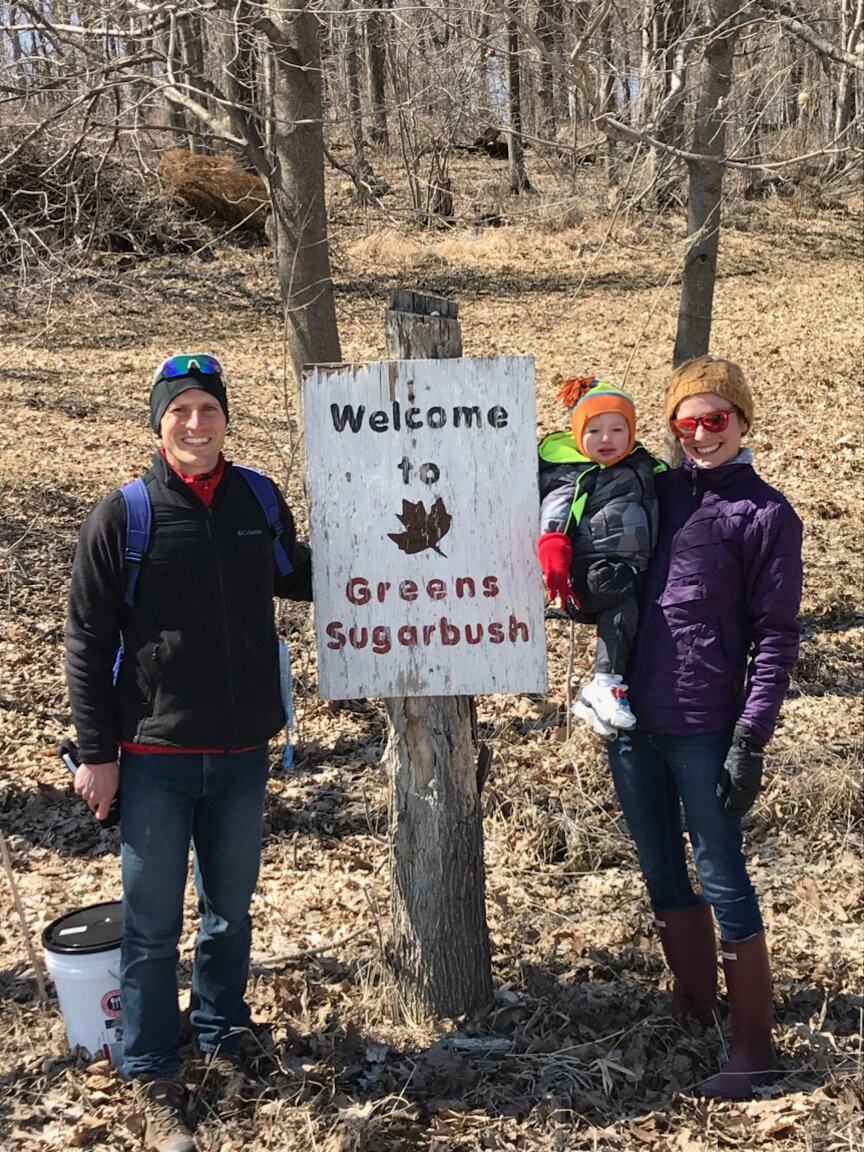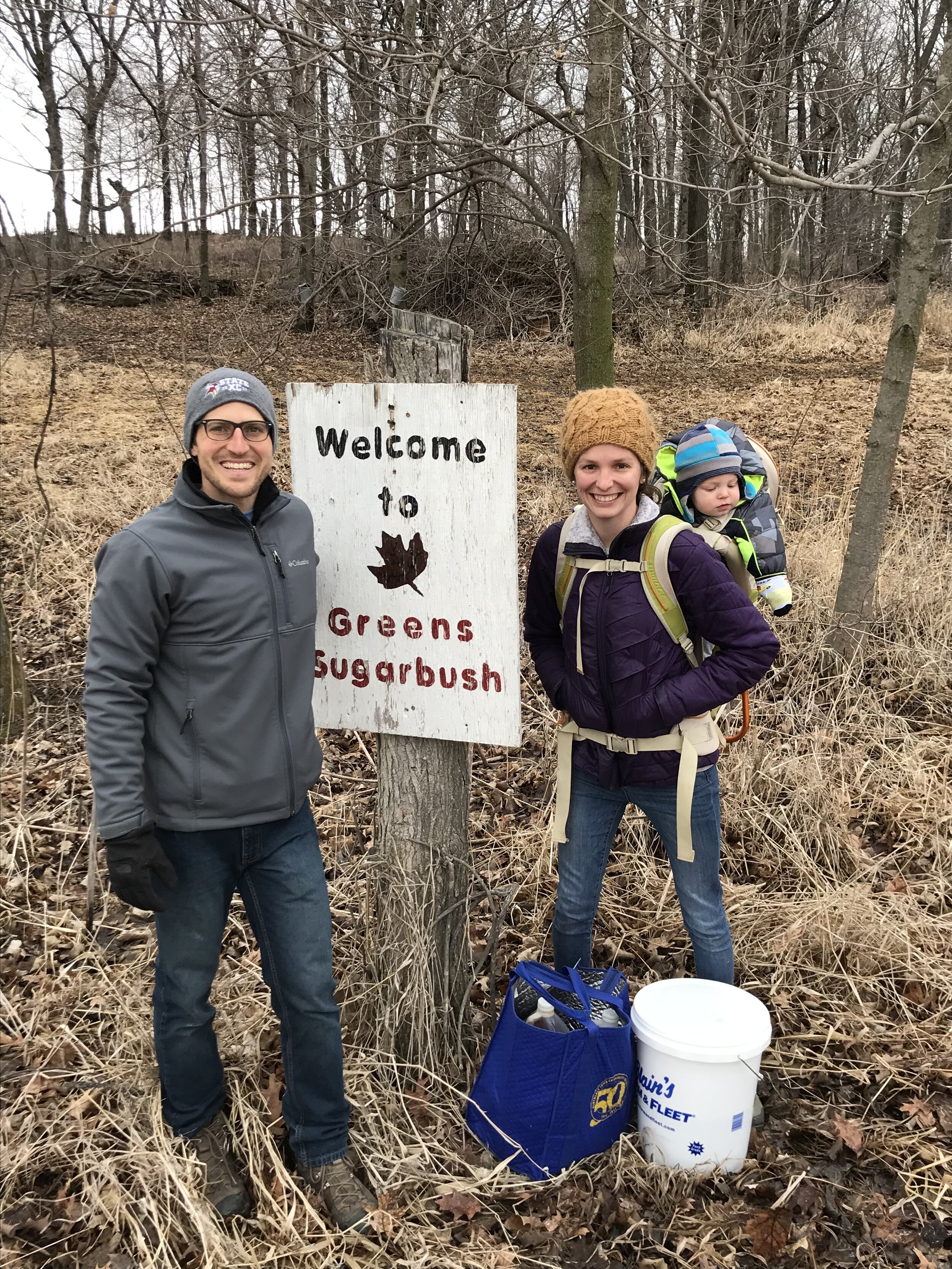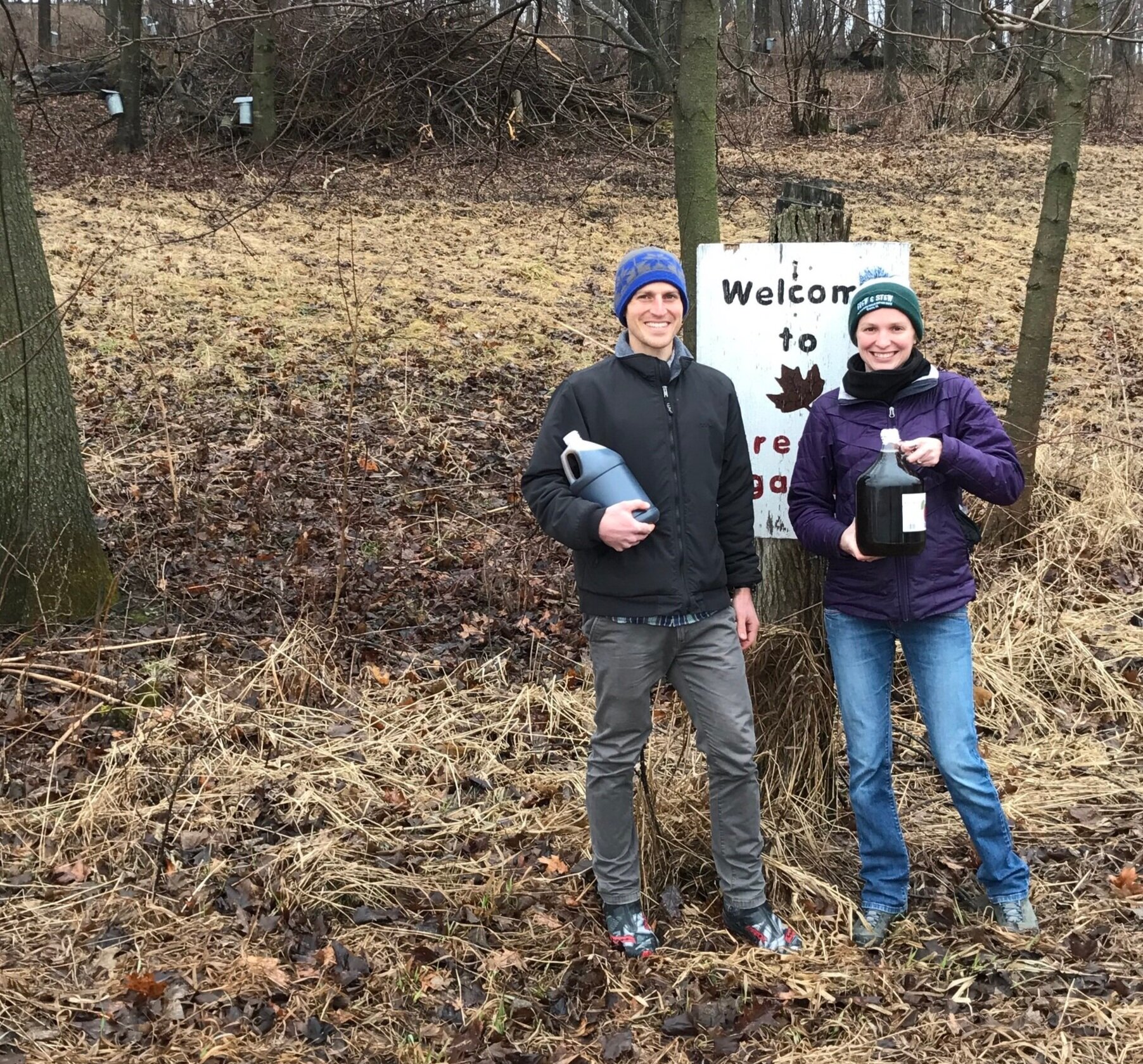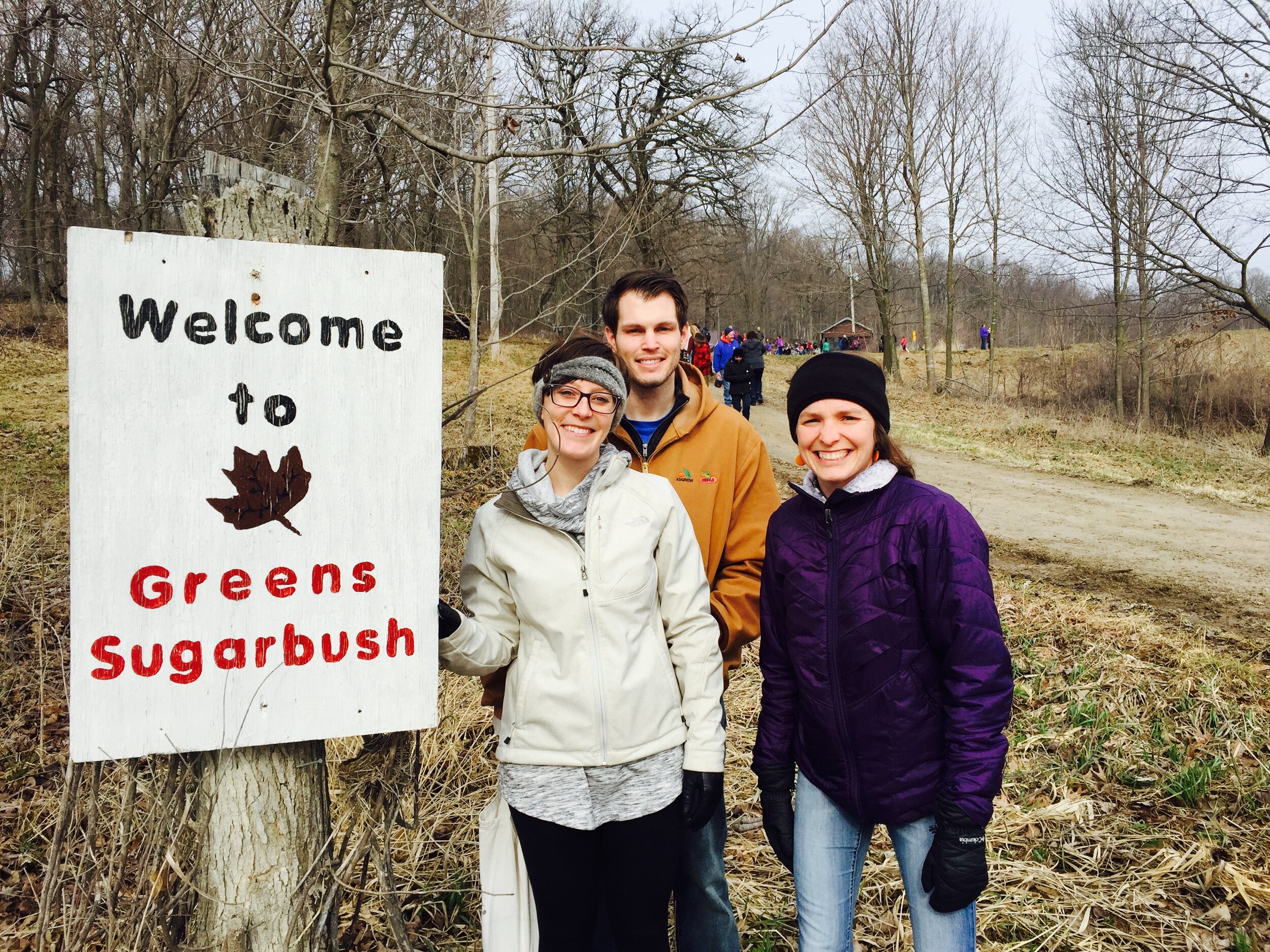Canning Maple Syrup
There are traditions that mark the passage of time in our household, as I’m sure there are in your family. For us they usually involve some act of food acquisition or preservation, such as canning salsa, making pesto, making pepper jelly, visiting an orchard and making applesauce, going to SnowPac to stock up on frozen berries, visiting Mennonite greenhouses for potted plants, and the annual Decorah garage sale weekend (… wait Adam tells me this isn’t food related, but he doesn’t know about my annual white chocolate chip raspberry muffin from the local coffee shop).
We’ve been attending a maple syrup festival called Green’s Sugar Bush for the last 5 seasons. A sugar bush is a stand of trees used for collecting maple syrup. Oh, how we wish we had our own stand of maples, but alas we have a stand of black walnuts. I have yet to acquire the taste for these.
The festival always includes a big big pancake feed, with a line that usually takes a solid 1.5-2 hours and the chance to purchase syrup or maple syrup candies.
Green’s Maple Syrup Festival … take note of the “short" (ha) line for the pancake and sausage feast.
The typical line of cars at the maple syrup festival. Photo from 2019.
We weren’t sure our annual sugar run was going to happen this season due to COVID-19 and the social restrictions. Their festival has been postponed until the Fall, but we were still able to pick up syrup from their little sugar shack. We pretty much have our maple syrup use down to a science and know we need 4 gallons to see us through until the subsequent syrup festival.
I grew up smothering puddles of Aunt Jemima on my Dad’s infamous Uncle Bill pancakes. I suppose the smothering habit hasn’t died, but my taste palate has shifted. For those of you who’ve never had real maple syrup you’re missing out on a big treat. We use maple syrup for waffles and pancakes, which we make at least once a week in our house. We also use maple syrup on our homemade plain yogurt. We used to make granola using maple syrup, which honestly I think I overdosed on and we haven’t made it recently.
Our bill came to $189 for 4 gallons, mind you it’s cheaper to bring your own container. We have two recommendations if you’re buying in bulk:
1.) Don’t use glass - we witnessed someone break their full gallon-sized jar of maple syrup. Ouch
2.) We were told this year not to let the syrup sit for any length of time in the plastic jugs as the syrup will start to adopt the flavor of whatever was previously in the jugs, which for us would have been vinegar.
You might scoff at $47.25/gallon (very reasonable and competitive by industry standards), but we are supporting their family’s livelihood. We feel an overwhelming sense of do-good satisfaction in that and the flavor. The flavor. It transforms me to some life I’ve never lived - to long picnic tables in the mess hall of some backwoods Vermont Boy Scout camp, with wood-fire permeating the taste of sausages and the stacks of fluffy buttermilk pancakes oozing with the sweetness.
How to store maple syrup
Canning process - How to can maple syrup using a water bath. It’s NOT hard.
You will need:
Water (boiling)
4 burner stove
A canner (large pot) + rack
3 other pots - one for steaming jars, one for steaming lids/rings and one for heating syrup
Clean mason jars
New lids + rings
Ladle, funnel, tongs
Towels
Steps:
First and foremost, use caution when working with boiling liquid
1.) Fill the canner with water on the stove. The water should be approximately 2/3 to the top of the pot.
2.) Heat maple syrup to boil on stove.
3.) Sanitize mason jars either by washing with warm water/soap or run through a dishwasher cycle.
4.) Use about 2-3 inches of water and steam mason jars, lid-side down, in large pot on stove while syrup comes to a boil
5.) Put about 2-3 inches of water in a smaller pot and steam the new lids and rings
6.) Once syrup is boiling, remove pot from stove and place on counter. Take a mason jar and fill the jar using ladle, leaving about 1 inch of headspace at top (we usually fill until the point where the body of the jar meets the top).
7.) Quickly place lid and ring on mason jar and tighten, take care not to over-tighten.
8.) Fill as many jars as you can fit in your water bath (we can fit 5 quart jars into our canner). Once these jars are full, put the mason jars into the canner. The water should be boiling and hot. Let the jars sit in the boiling water for about 15 minutes.
9.) Once done, CAREFULLY place the mason jars on a protected surface (a couple of bath towels) and wrap them up. They will be hot, so use caution. Let them cool slowly and naturally for about 12 - 24 hours. Check the lids. They should have sealed, in other words they shouldn’t make a popping sound.
5 years in Green’s Sugar Bush signs. Note the selfie in 2020. Not a soul around to take the photo and Linden zzz’ing in the car.
Welcome: Tailwind Acres
There is a bit of irony that our first Tailwind Acres blogpost should be about homesteading and we are in thick of a pandemic. We speculate backyard homesteading will make a stronger emergence into mainstream culture after the COVID-19 pandemic subsides.
I hear it’s hard to find flour and yeast in the local groceries. Lately, I’ve seen more homemade bread loaves on my Facebook feed than kitten memes. We’ve heard that times of uncertainty are good for garden seed sales and indeed there has been a big uptick in seed purchasing. I also hear chicks are darn near impossible to mail order.
We’re accustomed to our own version and routine of homesteading. Aside from not going to our places of employment, we haven’t altered our practices. In weekend ritual Adam whipped up two loaves of bread today. Normally one would go into the freezer to pull out during the work week. Then half of one of the loaves would be consumed by the three of us fresh out of the oven. Today’s loaf was predictable, but no less delightful oozing with almond butter and honey. We took inventory of our seed collection back in December and received our shipment of seeds on January 13, two days after China had its first confirmed death from Coronavirus and before it hit U.S. soil. In fact, most seeds are germinated and under our bank of grow lights. We're not rationing eggs and collecting about 12-14 per day.
We’re watching the world react in a way that makes us feel very, very fortunate to have the ability to grow and nurture our own food in our backyard. We did this when we lived in town, through trial and error we found tricks that work for us. That’s the beauty in gardening, every year is cumulative. You always learn something from a season. Even if it’s let’s not do that again.
Did I mentioned we continue to fail at things? We continue to fail at things! We’ve never mastered storage potatoes. Please help us if you have tips. Inevitably our potatoes get so many eyes they’re some creatures from Monsters, Inc or worse yet, Alien.
Mind you we do feel accomplished by other things. We still have a few mangy fingerlings, frozen basil and cilantro based pesto, frozen enchilada sauce, frozen tomatoes, canned salsa, and jars of maple syrup. We recently used our last carrots and beets that we tried storing in sand for the first time, and we just used our last head of garlic this past week (mind you we planted 400 cloves this past fall so there will be NO shortage this year, baring no crop failure).
Indeed, we feel more and more acclimated and adjusted to life at Tailwind. We have been here long enough to have witnessed every season at least once to make subtle observations that’ll guide our future decisions. The list of things we want to do keeps growing. Truth is that our “reality list” is take our “dream list” cut it in half and then halve it again. I consider ourselves want-to-be-farmers (ok, I have milked a cow...once.)
If any of you have read this far, you’ll likely point out that I’m not doing a great job in sales. Rest assured, we are dabbling and experimenting with selling produce because frankly we hope it inspires YOU to try a hand at growing your own food. Will there be errors? Absolutely! Will there be unexpected victories. I hope!
I speak with more confidence and assertion when it comes to our ability to share, ad nauseam, the fitness aspects of our life. We have ~40 years of combined competitive running experience between us and are eager to share bits and pieces of what we’ve been learning about our running journey, tips for training, injury prevention and all around runner self-care.
The current situation hasn’t changed our training too much. Adam always trains solo, but now instead of running over his lunch and after school, he’s been setting the alarm for 5:45AM and taking to the gravels or treadmill. I’m missing runs with a colleague from work, but otherwise I’m running and becoming more accustom to some of the local gravels. We both have expressed we miss immediate access to pavement.
The other day, it was windy. It’s always windy here, but even by flat land standards… it was a windy day. I was dragging my feet to start my run. Adam and Linden dropped me off about 7 miles from home so I wouldn’t have to do my tempo run into a headwind [insert, awesome husband award!] It was the first run I’d done since Adam came up with the name Tailwind Acres. As I ran home I couldn’t help but chuckle. What an appropriate name.
Tailwind: : a wind having the same general direction as a course of movement
We’re not naive enough to think this will be the last pandemic nor the fact that we face immensities of climate change, habitat destruction, loss of biodiversity, pollution… that all threaten our immediate ways of life and human survival. I hope a year from now, I’ll look back on this posting with relief that our world has rid itself of the immediate threat of COVID-19. More so, I hope we are smarter, more engaged, more nimble and willing to refocus on taking care of each other and the mothership. I can’t help but feel the tailwind.
Tailwind : a force or influence that advances progress toward an improved condition




